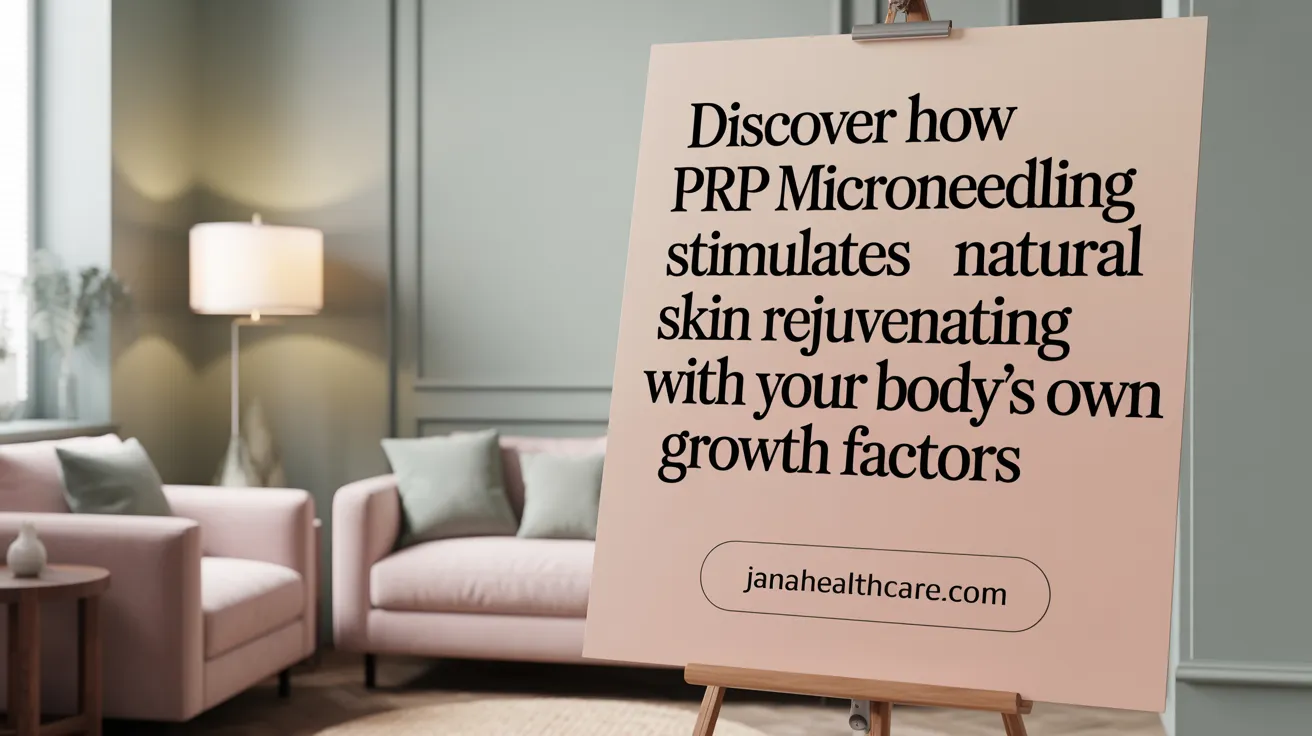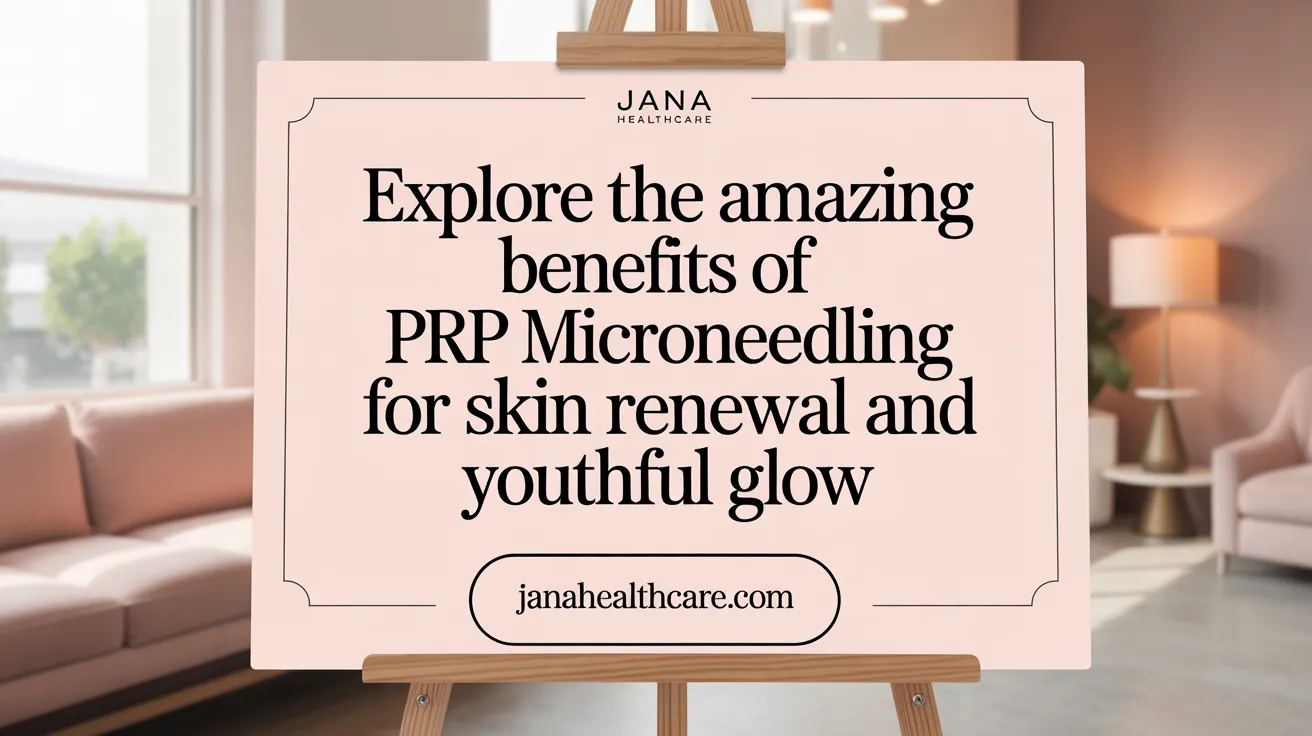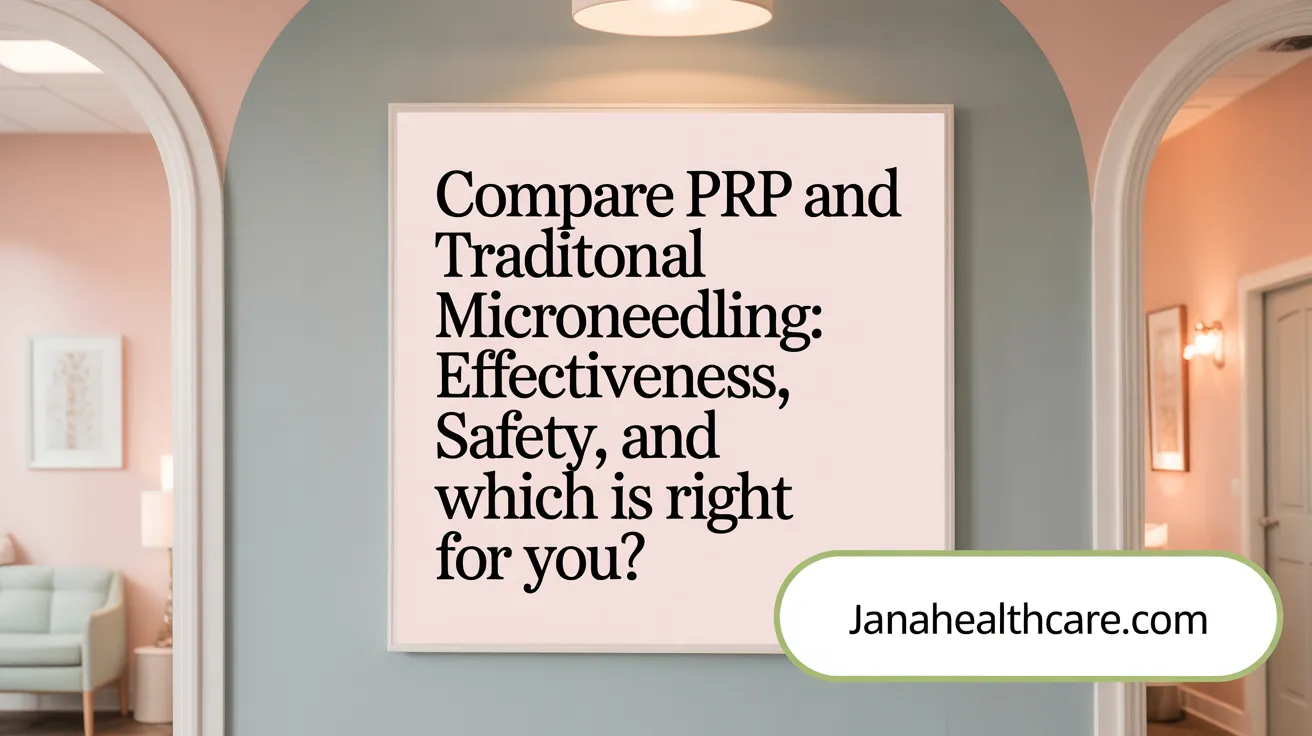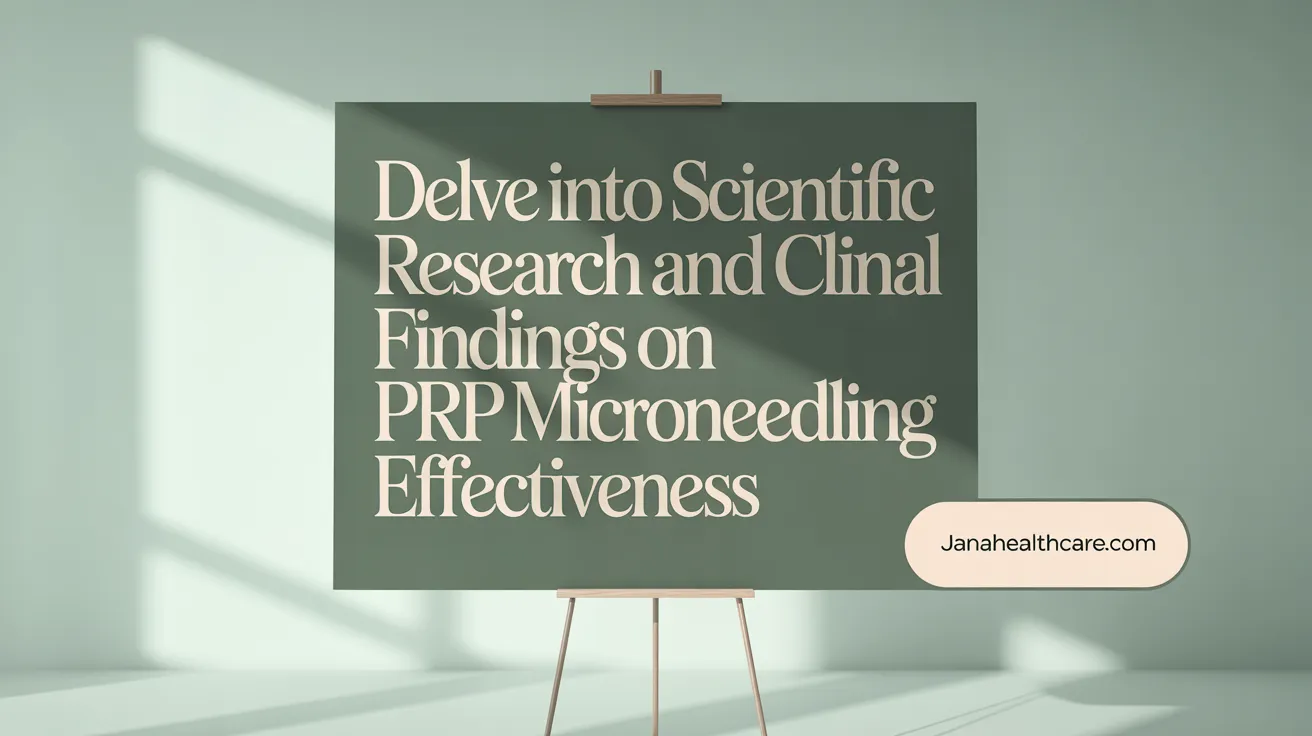Understanding PRP Microneedling
PRP microneedling is rapidly gaining popularity as an innovative skincare treatment that promises enhanced rejuvenation by combining microneedling with platelet-rich plasma (PRP). But what exactly is PRP microneedling, and how effective is it compared to traditional methods? This article explores the science, benefits, side effects, recovery, costs, and suitability of PRP microneedling to help readers decide if it's the right choice for their skincare needs.
What is PRP Microneedling and How Does It Work?

What is PRP microneedling and how does it work?
PRP microneedling is a cosmetic skincare procedure that combines the benefits of traditional microneedling technique with the application of platelet-rich plasma (PRP). Microneedling involves using a device equipped with tiny, sterilized needles to create controlled micro-injuries on the skin's surface. These micro-injuries trigger the body's natural healing response, stimulating the production of collagen and elastin, which are essential proteins for skin firmness and elasticity.
The role of PRP in this treatment enhances the healing and rejuvenating effects. PRP is derived from the patient’s own blood, which is drawn and processed in a centrifuge to concentrate the platelets. Platelets are rich in growth factors and proteins that promote tissue repair, cell growth, and collagen synthesis.
When PRP is applied during microneedling, either by topical application or injection, it penetrates deeply into the micro-injuries. This synergy accelerates healing, reduces inflammation, and boosts collagen and elastin production more effectively than microneedling alone.
The procedure generally takes about 30 to 60 minutes, is minimally invasive, and suitable for all skin types. Patients typically see gradual improvements in skin texture, tone, and overall appearance over the course of several weeks. It is considered safe, with minimal downtime, and is often performed in a series for optimal results.
Benefits and Advantages of PRP Microneedling for Skin Rejuvenation
 PRP microneedling offers numerous advantages for enhancing skin appearance and addressing various skin conditions. One of the main benefits is the significant improvement in skin texture and tone, helping to achieve a brighter, smoother complexion. This treatment effectively reduces fine lines, wrinkles, and scars, including acne scars and surgical marks, by stimulating natural healing processes.
PRP microneedling offers numerous advantages for enhancing skin appearance and addressing various skin conditions. One of the main benefits is the significant improvement in skin texture and tone, helping to achieve a brighter, smoother complexion. This treatment effectively reduces fine lines, wrinkles, and scars, including acne scars and surgical marks, by stimulating natural healing processes.
The combination of microneedling with platelet-rich plasma (PRP) enhances collagen and elastin production at deeper skin layers. The growth factors found in PRP accelerate tissue regeneration, leading to quicker and more noticeable results than traditional microneedling alone.
Patients often experience faster healing times and minimal downtime, typically only a few days of redness or swelling. This makes PRP microneedling a convenient option for those seeking effective skin rejuvenation without prolonged recovery.
Moreover, the procedure is versatile and suitable for various skin concerns such as hyperpigmentation, enlarged pores, and general skin brightness. It is safe for all skin types and colors, promoting natural regeneration with a high safety profile.
Multiple sessions are generally recommended to achieve optimal results, and the treatment also supports overall skin health by boosting tissue regeneration. Overall, PRP microneedling combines the power of regenerative medicine with minimally invasive techniques, delivering comprehensive skin renewal and a more youthful appearance.
PRP Microneedling Versus Traditional Microneedling: Effectiveness and Safety

How does PRP Microneedling compare to traditional microneedling in terms of effectiveness and safety?
PRP (Platelet-Rich Plasma) microneedling generally surpasses traditional microneedling in achieving more noticeable skin improvements, especially for deeper scars, persistent wrinkles, and more severe skin concerns. The primary advantage of PRP microneedling lies in the incorporation of growth factors derived from the patient’s own blood, which enhances collagen and elastin production, expedites healing, and stimulates tissue regeneration.
Traditional microneedling works by creating micro-injuries to stimulate the skin’s natural repair process, leading to improved texture, reduced scars, and signs of aging. However, without add-ons, the healing response may be less robust, often requiring multiple sessions and longer recovery times.
In terms of safety, both treatments are considered minimally invasive and safe when performed by qualified practitioners. Common side effects include temporary redness, swelling, and mild discomfort, which tend to resolve within a few days. The added step of blood draw and plasma preparation in PRP microneedling introduces a slight complexity and increases treatment duration and cost, but this also contributes to potentially faster results and higher patient satisfaction.
Most patients tolerate both procedures well, but PRP microneedling is especially beneficial for candidates with significant scarring, skin laxity, or those seeking quicker, more robust results. Overall, PRP microneedling offers a synergistic boost in promoting collagen synthesis and tissue healing compared to traditional methods, making it a preferred choice for more challenging skin issues.
Typical Results, Before-and-After Outcomes, and Treatment Regimen
What typical results and improvements can be expected from PRP microneedling, including before-and-after outcomes?
PRP microneedling generally enhances skin texture, tone, and overall appearance. Patients can expect a noticeable reduction in fine lines, wrinkles, and scars—especially acne scars—along with a brighter and more even complexion. Many individuals see a visible improvement in skin firmness and elasticity, with skin appearing plumper and more youthful.
Timeline for visible results
Results typically start to become visible around 10 days post-treatment, with ongoing improvements over the next several weeks. Collagen production continues to enhance the skin’s structure, leading to smoother and more refined skin texture as the remodeling process unfolds.
Number of sessions typically required
Most patients benefit from a series of two to three sessions, spaced four to six weeks apart. For more significant concerns, such as deep scars or pronounced aging signs, additional treatments may be recommended. Consistency over multiple sessions helps achieve the best and most lasting outcomes. See more about recommended treatment sessions.
Long-term maintenance needs
While results can last from six months to a year or more, ongoing maintenance treatments are often advised to sustain and enhance skin quality. Routine sun protection, good skincare, and follow-up sessions help prolong the rejuvenating effects. Check details on maintaining microneedling results.
Patient satisfaction and natural appearance
Patients frequently report high satisfaction, appreciating the natural-looking results without laser or surgical intervention. Because PRP uses the body’s own growth factors, improvements appear gradual and authentic, maintaining the natural beauty of the skin while providing rejuvenation with minimal risk and minimal downtime.
Scientific Evidence and Clinical Studies on PRP Microneedling Efficacy

What scientific research and clinical evidence support the efficacy of PRP microneedling?
Research on the effectiveness of PRP microneedling shows a varied picture. Several studies indicate that adding Platelet-Rich Plasma (PRP) or Platelet-Rich Fibrin (PRF) to microneedling can enhance skin rejuvenation, improve skin texture, and reduce scars.
Some clinical trials report positive outcomes, such as notable improvements in acne scars, fine lines, and overall skin quality. For example, split-face studies compare microneedling with PRP versus microneedling with topical substances like vitamin C, finding that PRP often results in better scar reduction and higher patient satisfaction.
However, not all scientific evidence aligns with these positive findings. A recent randomized controlled trial involving women over 45 found no significant skin improvement from PRP injections combined with microneedling. The study suggested that age and advanced skin aging could influence results, with PRP showing little advantage over saline placebo.
Overall, while there are promising signs that PRP and PRF can promote skin healing and rejuvenation, the current scientific consensus emphasizes the need for larger, more rigorous studies. Many existing reviews point out that the evidence must be expanded to firmly establish definitive benefits of combining PRP with microneedling.
In conclusion, some data supports the regenerative potential of PRP in skin treatments, but inconsistencies highlight the importance of continued research to better understand its true clinical value.
Stay informed: Search for "scientific research and clinical trials on PRP microneedling effectiveness" to explore the latest findings and ongoing studies.
Recovery, Healing Process, and Post-Treatment Care for PRP Microneedling
 Recovery from PRP microneedling generally involves experiencing mild redness, swelling, and sometimes light scabbing, which usually last around 5 to 7 days. The redness often diminishes within 24 to 48 hours, allowing most patients to resume daily activities quickly. The healing process actively involves collagen production and skin renewal, with complete results typically developing over a period of 4 to 6 weeks. Significant improvements in skin texture, tone, and overall appearance are usually visible by this time.
Recovery from PRP microneedling generally involves experiencing mild redness, swelling, and sometimes light scabbing, which usually last around 5 to 7 days. The redness often diminishes within 24 to 48 hours, allowing most patients to resume daily activities quickly. The healing process actively involves collagen production and skin renewal, with complete results typically developing over a period of 4 to 6 weeks. Significant improvements in skin texture, tone, and overall appearance are usually visible by this time.
Post-treatment care is vital to ensure optimal healing and results. Patients should avoid sun exposure, protect their skin with a broad-spectrum SPF 30+ sunscreen, and steer clear of harsh skincare products for several days. It is recommended to use gentle cleansers and moisturizers to support skin recovery. Activities that generate heat, such as vigorous exercise, hot showers, or saunas, should be avoided for at least a week to prevent irritation.
Additional precautions include refraining from aggressive treatments like chemical peels or other skin resurfacing procedures for at least two weeks. Maintaining good hydration, proper sleep, and stress management can further enhance recovery. It is important to watch for signs of infection or adverse reactions, such as increased redness, unusual pain, or pus, and seek medical advice if any abnormalities arise. Overall, careful post-treatment care and patience are essential to achieve the best long-term results from PRP microneedling.
Risks, Side Effects, Suitability, and Cost: Is PRP Microneedling Worth It?
What are the possible side effects, risks, and adverse reactions associated with PRP microneedling?
Potential side effects of PRP microneedling are generally mild and include redness, swelling, bruising, mild pain, and transient skin irritation, all of which typically resolve within days to weeks. Serious adverse reactions are rare but can involve infection, allergic hypersensitivity, hyperpigmentation—particularly in darker skin types—or scarring if proper hygiene and technique are not maintained. Bacterial infection is a risk if bacteria enter through the micro-injuries, emphasizing the importance of proper antiseptic procedures. While PRP is derived from the patient's own blood, reducing allergic reactions, caution should be exercised in individuals with active infections, blood disorders, or during pregnancy. Following pre- and post-treatment care, including sun protection and avoiding irritating products, can significantly minimize risks and promote safe healing.
How suitable is PRP microneedling for different skin types and conditions?
PRP microneedling is generally suitable for most skin types and tones, offering benefits such as improved texture, firmness, and reduction of scars and pigmentation issues. It is effective for aging skin, dry skin, oily and acne-prone skin, as well as combination skin, with treatments tailored to individual needs by adjusting needle depth and plasma application. The procedure can be safely performed on sensitive skin, but caution is advised for those with active skin infections, active acne, or keloid tendencies. Individuals with medical conditions like blood disorders or those on blood-thinning medications should seek medical advice before treatment. Overall, while PRP microneedling is versatile and minimally invasive, personalized assessment is essential to determine its suitability and optimize outcomes for different skin conditions.
What are the cost considerations of PRP microneedling, and is it worth the investment?
PRP microneedling is generally more costly than traditional microneedling due to the added procedures of blood draw, PRP preparation, and the expertise required, with prices varying based on treatment area, number of sessions, and clinic location. Typical costs range from approximately $500 to $3,500 per session, depending on whether the treatment targets the face, under-eye area, or scalp, among other factors. While the higher price reflects the use of high-quality PRP, advanced equipment, and skilled providers, many patients find that the enhanced collagen stimulation, faster healing, and longer-lasting results make it a worthwhile investment. Additionally, optimizing results may require multiple sessions spaced several weeks apart, adding to the overall expense. Ultimately, whether it is worth the investment depends on individual skin or hair goals and budget considerations, but for those seeking natural skin rejuvenation with minimal downtime, PRP microneedling often provides significant benefits.
Is PRP Microneedling Worth It?
PRP microneedling stands out as a promising treatment that harnesses the body's natural healing powers to improve skin texture, appearance, and overall rejuvenation. While scientific evidence is mixed and some benefits may be subtle or vary depending on individual factors such as age and skin condition, the procedure offers a minimally invasive, relatively safe option with manageable side effects and a quick recovery. Its ability to accelerate healing and enhance collagen production often translates to faster and potentially more noticeable results than traditional microneedling alone. However, it comes at a higher cost and requires multiple sessions for optimal effect. Ultimately, PRP microneedling can be a valuable option for those seeking natural skin rejuvenation, especially for treating scars and fine lines, provided that expectations are realistic and treatment is conducted by qualified professionals. Consulting with a skincare specialist is essential to tailor the approach and maximize outcomes, helping patients decide if this investment aligns with their skincare goals and budget.
